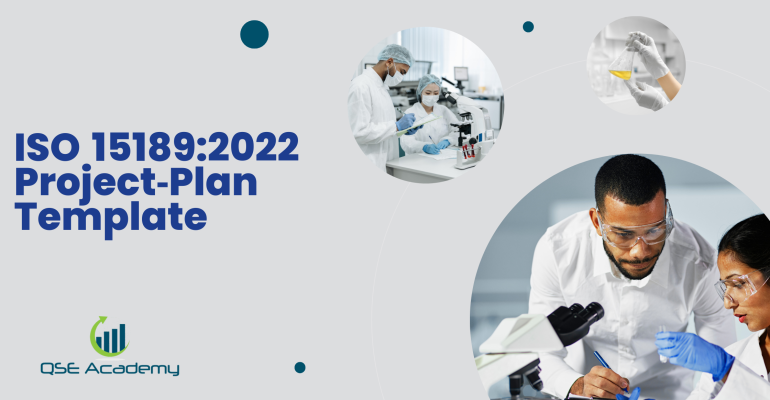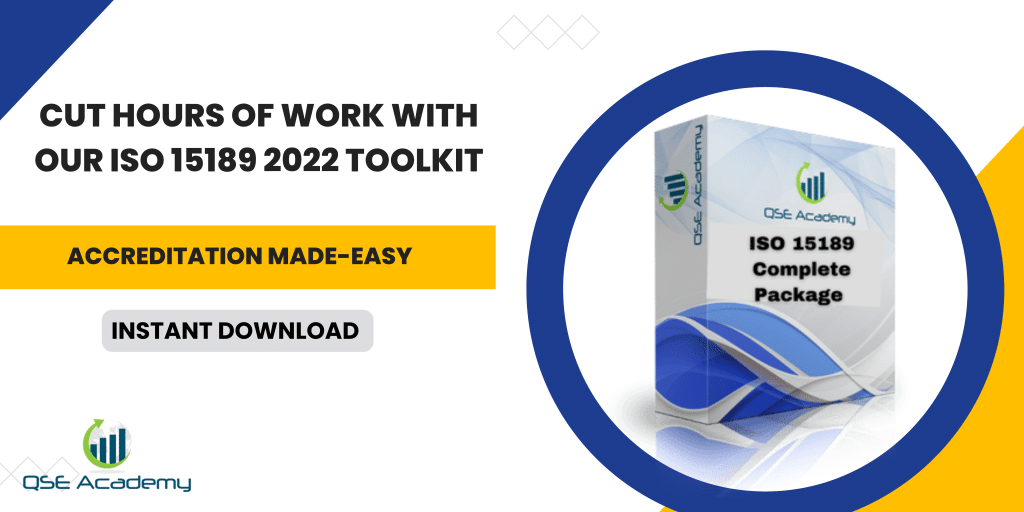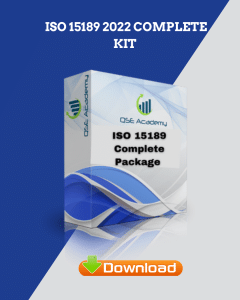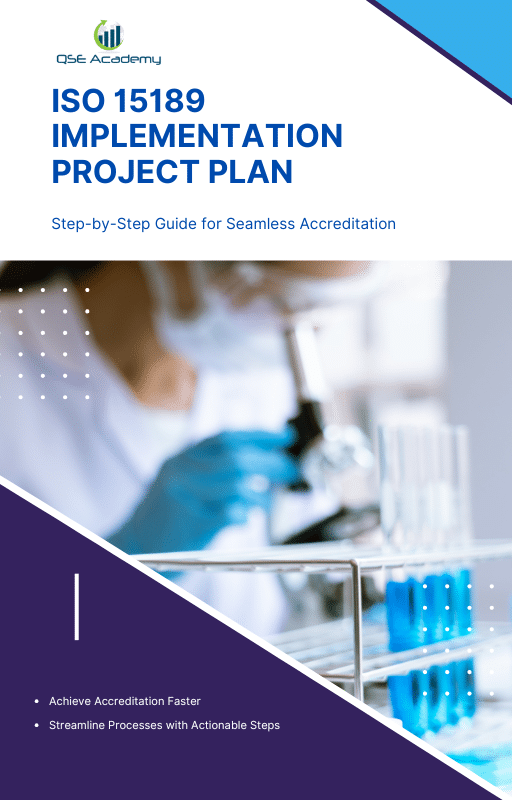ISO 15189:2022 Project‑Plan Template
Last Updated on October 22, 2025 by Hafsa J.
Why You Need a Clear ISO 15189:2022 Project Plan
Here’s what I’ve noticed working with medical laboratories: most teams start their ISO 15189 journey full of enthusiasm—then hit a wall when they realize how many moving parts need to come together. Documentation, staff training, internal audits, management reviews—it’s a lot to handle all at once.
That’s where a clear, structured project plan becomes your best friend. It turns that overwhelming list of requirements into an organized roadmap you can actually follow.
In my experience, labs that use a written project plan get accredited faster, avoid unnecessary stress, and keep their team accountable from day one.
This article walks you through how to build that plan, step by step—so you can stay compliant, confident, and audit-ready without burning out your team.
Now that we’re clear on why it matters, let’s look at what ISO 15189 actually expects from your planning process.
Understanding ISO 15189:2022 Project-Planning Requirements
ISO 15189 doesn’t give you a ready-made project plan—but it absolutely expects you to think like a project manager. The standard wants your laboratory to plan, implement, and maintain a management system that ensures consistent, competent results.
That starts with structure. You need clear responsibilities, defined resources, and timelines that align with Clauses 4 to 8—covering everything from impartiality and equipment control to risk management and continual improvement.
Here’s what I’ve seen work best:
Start by mapping your scope of accreditation, identifying key laboratory processes, and then breaking them into manageable work packages. Each one should have a responsible person, due date, and deliverable.
Pro Tip: Don’t skip leadership involvement at this stage. When top management isn’t engaged early, projects stall fast.
And a common pitfall? Treating the plan like a document for the quality officer alone. It’s a cross-functional effort—your technical staff, quality manager, and even admin team all play a role.
Once your foundation is set, it’s time to dive into the first major phase—your Gap Analysis and Preparation.
Phase 1 – Preparation & Gap Analysis
Before writing a single procedure, you need to know where you stand. That’s what the gap analysis is for—it shows you the distance between your current practices and what ISO 15189:2022 requires.
In my experience, this phase sets the tone for everything that follows. A well-done gap analysis doesn’t just identify missing documents; it reveals process weaknesses, unclear responsibilities, and training needs.
Here’s how to tackle it:
-
Review each clause of ISO 15189 and mark where you already comply.
-
List out what’s missing—whether it’s documentation, calibration records, or management reviews.
-
Assign clear owners for each gap.
-
Create an action plan with deadlines and measurable outcomes.
Pro Tip: Don’t treat this as a one-person job. Bring in section heads and technical staff for honest input. They’ll often spot nonconformities before the auditor ever does.
Common mistake: Jumping straight into documentation without this phase. It leads to wasted effort and rework later.
Once your gaps are clear, you can confidently move into Phase 2 – Documentation Development & Implementation.
Phase 2 – Documentation Development & Implementation
Now that you know your gaps, it’s time to build your Quality Management System (QMS) piece by piece. This is where most labs either gain momentum—or lose it.
Start with the Quality Manual. It’s your top-level document that connects every process, SOP, and record in your system. From there, develop policies and procedures that address each ISO 15189 clause—everything from sample handling and test verification to risk management and data integrity.
Here’s what I’ve seen work best:
-
Create a clear document hierarchy: manual → policies → SOPs → forms/records.
-
Involve the people who actually do the work. If your staff doesn’t help write or review SOPs, they won’t follow them.
-
Implement changes gradually—don’t drop 50 new procedures overnight.
Pro Tip: Validate every new SOP in real conditions before approval. A beautifully written document that doesn’t fit actual lab workflow will only frustrate your team.
Common pitfall: Copying templates word-for-word without adapting them. ISO 15189 expects procedures to reflect your lab’s real processes, not generic statements.
Once your documents are developed and implemented, it’s time to test the system through internal audits and management review.
Phase 3 – Internal Audit, Management Review & Corrective Actions
This phase is where you stress-test your system before the real accreditation audit. Think of it as your rehearsal.
Start with internal audits. Train a few team members as internal auditors and schedule audits that cover every process at least once. The goal isn’t to assign blame—it’s to find what’s not working while there’s still time to fix it.
Next comes the management review. This meeting should bring together leadership and the quality team to discuss audit results, objectives, resources, and improvement plans. It’s your chance to demonstrate commitment and drive continuous improvement, both key points auditors look for.
Pro Tip: Treat nonconformities as learning tools, not failures. The best labs use audit findings to fine-tune their systems long before the accreditation visit.
Common mistake: Doing a rushed management review just to “tick the box.” Auditors can tell. Make it meaningful by discussing real data—complaints, PT results, turnaround times, and improvement actions.
When your internal audits and management reviews show consistent performance, you’re ready for the big step—preparing for the accreditation assessment.
Phase 4 – Accreditation Application & Assessment Preparation
By now, your system is running, your team is trained, and your internal audits are complete. It’s time to face the accrediting body.
Start by choosing the right accreditation body—one recognized nationally or internationally. Then, prepare your application package, which usually includes your scope of accreditation, Quality Manual, list of procedures, and evidence of implementation.
Here’s what I’ve seen make the biggest difference:
-
Double-check that every document is current and controlled. Outdated versions are a red flag for assessors.
-
Organize your records by clause or process—make it easy for assessors to verify compliance.
-
Conduct a mock assessment a few weeks before the official one. It’s one of the best ways to uncover last-minute issues.
Pro Tip: Create an “Assessor Binder” (or digital folder) containing key documents—your project plan, internal audit results, corrective actions, and management review minutes. When assessors see this level of organization, it sets a positive tone from the start.
Common mistake: Treating the accreditation visit like an interrogation. It’s a partnership. Assessors want to see a functioning system, not perfection. Be open, cooperative, and transparent about how you manage risks and continuous improvement.
Once you’ve completed the assessment, celebrate—but don’t stop there. The next phase keeps your momentum going: maintaining and improving your system after accreditation.
Example ISO 15189 Project-Plan Template (Downloadable Structure)
At this point, it helps to see what the full picture looks like. Below is a simple structure you can adapt to your own laboratory. It outlines each project phase, expected timeline, key deliverables, and responsible roles.
| Phase | Estimated Duration | Key Deliverables | Responsible Roles |
|---|---|---|---|
| Preparation & Gap Analysis | 2–4 weeks | Gap report, action plan, defined responsibilities | Lab Manager, Quality Officer |
| Documentation & Implementation | 6–8 weeks | Quality Manual, SOPs, records templates | Section Heads, Quality Team |
| Internal Audit & Management Review | 4 weeks | Audit reports, management review minutes, CAPA records | Internal Auditors, Management |
| Accreditation Application & Assessment | 2–4 weeks | Final documentation, assessor binder, readiness checklist | QA Manager, Lab Director |
This layout keeps your project on track and ensures no task slips through the cracks.
Pro Tip: Treat this plan as a living document. Update it after every milestone—new audit results, changes in personnel, or revisions to procedures should all reflect here.
Common mistake: Letting the plan gather dust once the certificate is issued. Accreditation isn’t a one-time event—it’s an ongoing cycle of improvement.
Now that you’ve seen how to structure your plan, let’s talk about what comes next—keeping your lab accredited and improving year after year.
Maintaining Momentum After Accreditation
Getting accredited is a big milestone—but keeping that accreditation is where real quality management begins.
Once the certificate arrives, shift your focus to sustaining and improving your system. ISO 15189 expects you to continually evaluate performance, manage risks, and drive improvement based on data. That means internal audits, management reviews, and performance indicators should now be part of your lab’s regular rhythm—not just pre-audit exercises.
Here’s what I’ve seen successful labs do:
-
Schedule quarterly mini-audits or reviews to stay on top of compliance.
-
Track KPIs like turnaround time, error rates, and staff competency scores.
-
Review customer feedback and complaint trends regularly.
Pro Tip: Assign a “process owner” for each major function—sample management, equipment calibration, personnel competence, etc. This keeps accountability clear and ensures your quality system never becomes stagnant.
Common mistake: Waiting until the next surveillance audit to fix issues. Continuous improvement isn’t optional; it’s what sets high-performing laboratories apart from those always playing catch-up.
Now that we’ve covered every phase, let’s tackle some of the most common questions labs ask when planning their ISO 15189 projects.
FAQs – ISO 15189 Project-Planning Essentials
Q1. How long does ISO 15189 implementation usually take?
That depends on your lab’s size and readiness. Most laboratories complete the process within 4 to 8 months. If your documentation is already structured and staff are familiar with quality principles, you’ll be on the shorter end of that range.
Q2. Can small laboratories use the same project-plan template?
Absolutely. The same structure works whether you’re a two-technician clinic or a national testing center. You just scale the timelines and responsibilities. The key is to keep the sequence of steps—gap analysis, documentation, audits, review, then accreditation—intact.
Q3. What tools or software can help manage the ISO 15189 project plan?
Project-tracking tools or dedicated ISO compliance software work best. Many labs use QSE Academy’s ISO 15189 Implementation Manager because it tracks deadlines, document approvals, and audit results in one dashboard. The point isn’t which tool you choose—it’s that you actually use it to keep momentum.
Now, let’s wrap up with a short conclusion to tie it all together and give you a clear next step.
Your Next Step Toward ISO 15189 Accreditation
Building your ISO 15189:2022 project plan isn’t just about meeting requirements—it’s about giving your laboratory structure, focus, and confidence through every stage of accreditation.
By now, you’ve seen how each phase connects: start with a solid gap analysis, develop and implement your QMS documentation, validate your work through internal audits and management reviews, and finish strong with assessment readiness.
In my experience, labs that treat their project plan as a living document—not a one-time checklist—see faster approvals, smoother audits, and stronger teamwork overall.
If you’re ready to move forward, don’t start from scratch. Download QSE Academy’s ISO 15189:2022 Project-Plan Template—an editable roadmap built from real-world projects—or reach out for guided implementation support.
Your lab’s accreditation success starts with a plan. Let’s make it happen.
Whether it’s ISO 9001, ISO 22000, or the cosmetics-focused ISO 22716, I’ve spent my career I’m not here to call myself an expert—I prefer “enthusiast” because I truly love what I do. When I’m not writing about standards, you’ll probably find me playing Piano 🎹, connecting with people, or diving into my next big project💫. I’m an engineer specialized in the food and agricultural industry
make ISO standards less intimidating and more approachable for everyone.
turning complex jargon into clear, actionable steps that businesses can actually use.
There’s something incredibly rewarding about helping people navigate food safety and quality management systems
in a way that feels simple, practical, and even enjoyable.
I have a Master’s in QHSE management and over 12 years of experience as a Quality Manager
I’ve helped more than 15 companies implement ISO 9001, ISO 22000, ISO 22716, GMP, and other standards
My clients include food producers, cosmetics manufacturers, laboratories, and service companies
I believe quality systems should be simple, useful, and efficient.













